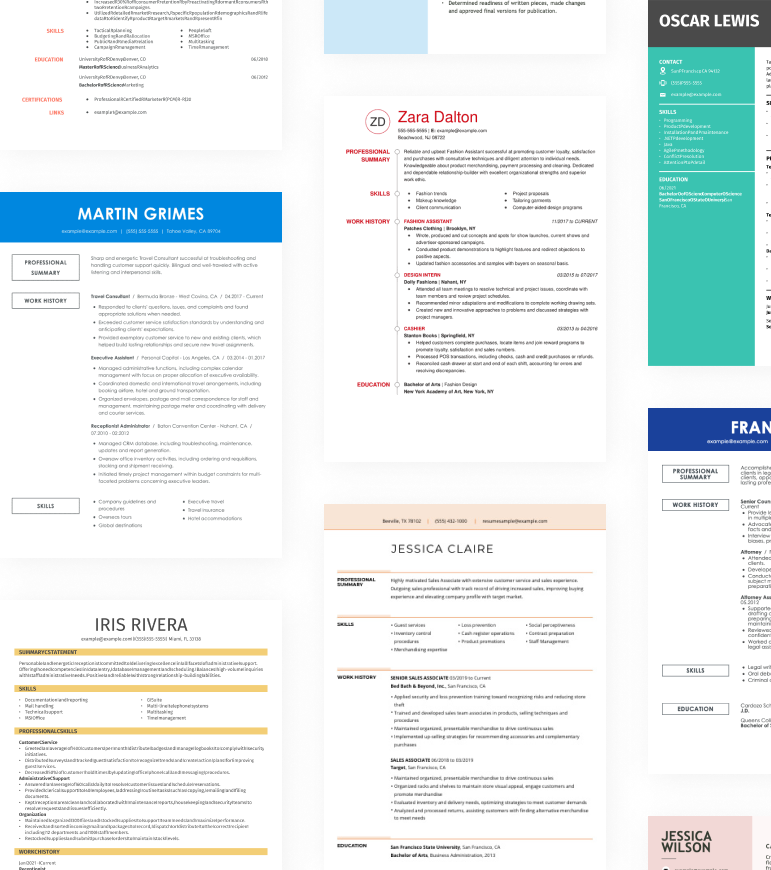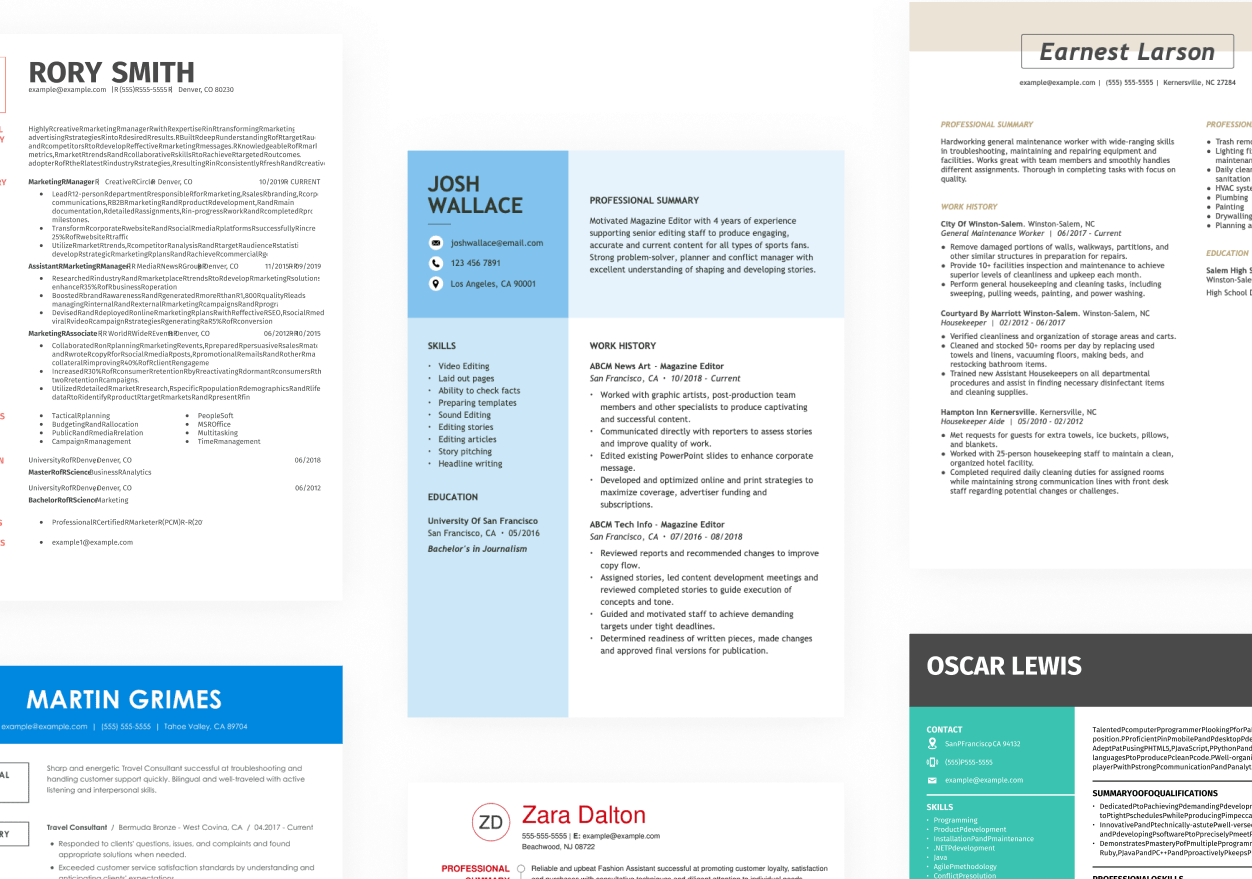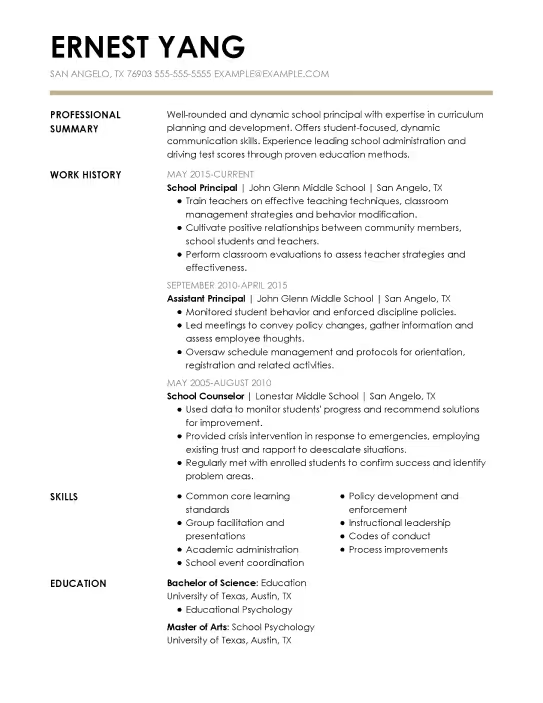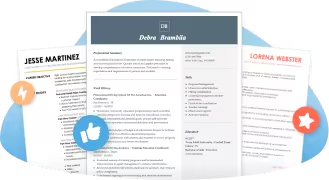Find the Best Resume Example for Your Job Search
Browse our curated list of the most searched industries and job titles. You’ll find access to our complete library below. You can also use our online Resume Builder to get tailored skills and writing suggestions, screen-friendly resume templates, and an ATS Resume Checker to beat the bots.
18 Popular Resume Examples for 2025
These top 18 resume samples offer a crash course on the best resume-writing practices across multiple experience levels and jobs. Pair this with our ATS-optimized resume templates and detailed “How to Write a Resume” guide to master recruiter-friendly writing strategies.
Additional Resume Samples by Style
A well-designed resume template can help highlight your qualifications while downplaying any potential weaknesses. The following resume designs can help you appeal to various recruiters and job openings.
Modern Resume
These streamlined modern resumes use simple borders and columns to help eyes quickly skim and process your skills and experience.
Traditional Resume
These traditional resume examples are best for traditional jobs like law, banking, finance and research.
Creative Resume
Use bright, playful resume examples to appeal to creative employers in marketing, media, music or entertainment.
ATS Resume
Study how ATS-optimized resume examples use strategic resume keywords, standard section headings and simple layouts to pass online gatekeepers.
Basic Resume
These simple and basic resume examples use minimal formatting, strategic line breaks, and generous white space to make your resume easy to read and digest.
Professional Resume
Whether you’re applying for a promotion or your first job, these professional resume examples use design and formatting to highlight your professionalism.
Resume Format Examples
We have resume examples in the three resume formats. Each format has unique pros and cons to highlight your best qualifications and downplay red flags like work gaps, lack of relevant experience, or frequent job changes.
Chronological Resume
Try the chronological resume if you have more than 10 years of experience. This resume format has the same sections mentioned above but dedicates most of the page space to your work history to highlight career growth, promotions and technical experience.
Functional Resume
If you have less than three years of experience, use a skills-based format like the functional resume to highlight your knowledge and downplay your short work history. You should only use this when applying in person — this customizable resume doesn’t do well with ATS.
Combination Resume
Also known as the hybrid resume examples, this layout dedicates equal space to your skills and work history. This combined format is best for candidates with three to nine years of experience and if you’re looking for a promotion or career growth!
Why Use Resume Examples?
- Find in-the-know job lingo.
- Recruiter-friendly look and feel.
- Describe up to a decade on a page.
- Describe up to a decade on a page.
- See multiple resume formats in action.


Resume Example FAQ
What is a resume example?
A resume example is a helpful job-seeking resource that teaches you how to highlight professional skills, experience and accomplishments.
Our examples teach you how to reframe the requirements from the job description based on your skills and achievements. These resume examples also reflect easy-to-read formatting, phrasing and design choices.
Why should I use resume examples?
You should use resume examples to understand your desired job and learn which qualifications are most appealing to hiring managers. Think of each job application as a test.
You should check out how to write a good resume and practice writing drafts to familiarize yourself with what experience and accomplishments you want to share with hiring managers. Using resume examples is like bringing a study guide to an open-book test — you can see how similar job seekers describe their experience, study how they frame their accomplishments, and pick up on common industry jargon.
Refer to our industry and specific job examples to see what skills, accomplishments, and experiences your fellow job seekers share with hiring managers. Learn what information you wish to share.
How do I adjust these resume examples to my needs?
These resume examples reflect the responsibilities and achievements of other job seekers. Adapt the elements you like from a resume example, whether the design, the way it’s organized, specific phrasing or an approach to the summary statement.
A good resume example will guide you as you create your document. But be careful not to copy entire sections word for word — your experience must be yours alone.
What should I include in my resume?
All resumes have the same five sections:
- Contact information
- A summary statement or objective statement
- Skills
- Work experience
- Education
A preformatted resume template with predefined sections, fonts and spacing saves you time and energy. We created these resume templates to ensure that all critical resume sections are presented with screen-friendly readability. These templates also follow applicant tracking system layouts to ensure these digital gatekeepers correctly grade your information.
How far back should a resume go?
Focus on your recent and relevant experience. Your resume should never go past 10 years unless:
- You’re returning to the workforce after an extended leave
- You’re a recent graduate with older, relevant experience.
- You’re applying for a leadership position in a related field.
- You’re changing careers and need to highlight transferable experience.
Is there any information I should remove from my resume?
Remove irrelevant details from your resume. Avoid additional information like hobbies or interests unless they relate to the job, like arts for a kindergarten teacher. Remove any information that doesn’t match the job ad (look for bolded keywords or repeated phrases).










